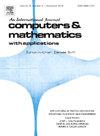具有熵稳定的多相级联晶格Boltzmann格式中力各向同性的影响
IF 2.9
2区 数学
Q1 MATHEMATICS, APPLIED
引用次数: 0
摘要
多相流的研究是自然科学和工程领域的一个重要课题。描述这种现象的建模方法结合了晶格玻尔兹曼方法(LBM)、介观Navier-Stokes解算器和Shan-Chen (SC)伪势方法,后者假设粒子间相互作用力在扩散界面内诱导自发相分离。为了解决初始SC-LBM在高密度比(DR)和动态粘度比(VR)下的不准确性和不稳定性,最近的文献提出了两种方法:通过受碰撞后熵最小化(KBC)约束的级联晶格玻尔兹曼方法(CLBM)增强碰撞过程,并扩展公式,同时调整相互作用力参数以帮助热力学一致性,从而阻尼寄生离散化效应并实现表面张力调谐。在我们的工作中,我们研究了粒子间力各向同性顺序和关键建模参数之间的相互作用如何影响KBC-CLBM离散化伪影和稳定性。在各向同性有效性层次方面取得的重要结果将指导未来的应用研究,采用合适的力模板,符合所需的物理参数(DR和VR),同时限制计算负担。在E8各向同性阶情况下,在DR≈3000和VR≈600时,静态测试得到的结果与热力学结果一致,杂散电流大小小于10−3晶格单元。即使在调谐的表面张力下,也证明了它符合拉普拉斯定律。液滴振荡实验结果与瞬态分析模型一致,特别是在E8,甚至在更高的DR和VR下,也存在表面张力调制。考虑到模型的能力,我们认为我们的工作结果是朝着更深入地理解自然现象和解决工程问题迈出的一步。本文章由计算机程序翻译,如有差异,请以英文原文为准。
On the effect of force isotropy in a multiphase cascaded lattice Boltzmann scheme with entropic stabilization
The study of multiphase flows is a pivotal topic in natural sciences and engineering. A modeling approach to depict such phenomena combines the Lattice Boltzmann Method (LBM), a mesoscopic Navier-Stokes solver, and the Shan-Chen (SC) pseudopotential method, the latter postulating an interparticle interaction force inducing a spontaneous phase separation within a diffuse interface. To handle the inaccuracy and instability of the naive SC-LBM at high density ratio (DR) and dynamic viscosity ratio (VR), a twofold approach is proposed in recent literature: enhancing the collision process by a Cascaded Lattice Boltzmann Method (CLBM) constrained by a post-collision entropy minimization (KBC), and extending the formulation while tuning parameters of the interaction force to aid thermodynamic consistency, thus damping parasitic discretization effects and enabling surface tension tuning. In our work, we investigate how the interplay between the interparticle force isotropy order and key modeling parameters affects the KBC-CLBM discretization artifacts and stability. The nontrivial results achieved in terms of isotropy effectiveness hierarchy would guide future applied research in the adoption of suitable force stencils, complying with the required physical parameters (DR and VR), while limiting the computational burden. Static tests yield thermodynamically consistent results with the spurious currents magnitude lower than lattice units at DR ≈3000 and VR ≈600 in the E8 isotropy order case. The compliance with the Laplace law has been proven, even at tuned surface tension. Droplet oscillation test results show consistency with transient analytical models, especially at E8 and even at higher DR and VR, also with surface tension modulation. Given the model's capabilities, we consider the outcome of our work as a step towards gaining a deeper understanding of natural phenomena and solving engineering problems.
求助全文
通过发布文献求助,成功后即可免费获取论文全文。
去求助
来源期刊

Computers & Mathematics with Applications
工程技术-计算机:跨学科应用
CiteScore
5.10
自引率
10.30%
发文量
396
审稿时长
9.9 weeks
期刊介绍:
Computers & Mathematics with Applications provides a medium of exchange for those engaged in fields contributing to building successful simulations for science and engineering using Partial Differential Equations (PDEs).
 求助内容:
求助内容: 应助结果提醒方式:
应助结果提醒方式:


